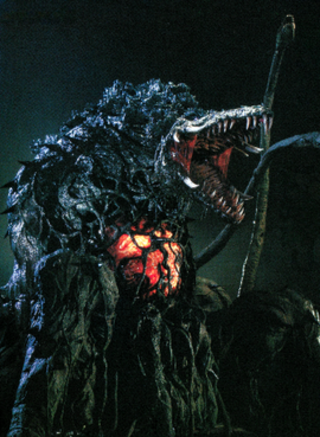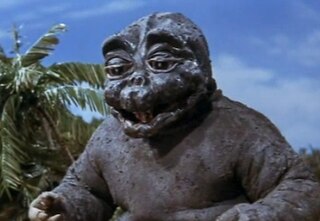 W
WAnguirus is a fictional monster, or kaiju, which first appeared in Godzilla Raids Again (1955), the second film in the Godzilla franchise. Anguirus is the first monster to be shown engaging in combat with Godzilla in a film. Since then, the character has appeared conversely as an enemy and an ally of Godzilla in numerous films produced by Toho, including Destroy All Monsters, Godzilla vs. Gigan, Godzilla vs. Megalon, Godzilla vs. Mechagodzilla, and Godzilla: Final Wars. He has also appeared in other media, including comic books and video games.
 W
WBaragon is a fictional monster, or kaiju, which first appeared in Ishirō Honda's 1965 film Frankenstein Conquers the World, produced and distributed by Toho. Depicted as a four-legged, horned dinosaur-like creature with large ears, Baragon appeared alongside Godzilla and other monster characters in films in the Godzilla franchise, also produced by Toho, including Destroy All Monsters and Godzilla, Mothra and King Ghidorah: Giant Monsters All-Out Attack.
 W
WBiollante is a rose hybrid kaiju who first appeared in Toho's 1989 film Godzilla vs. Biollante, and has since appeared in numerous licensed video games and comic books. The creature is portrayed as a genetically engineered clone of Godzilla spliced with the genes of a rose and a human. As the character was created during the end of the Cold War and a wane in the concerns over nuclear weapons represented by Godzilla, Biollante was conceived as a symbol of more contemporary controversies regarding genetic engineering.
 W
WDestoroyah is a crustacean kaiju who first appeared in Toho's 1995 film Godzilla vs. Destoroyah.
 W
WEbirah is a kaiju film monster taking the form of an enormous monstrous lobster. The name Ebirah is a portmanteau of the Japanese word for "shrimp" or "lobster" and the -ra ending often appended to the names of kaiju monsters, such as Mothra, Hedorah, Ghidorah, etc. and Godzilla himself.
 W
WFrankenstein's monster or Frankenstein's creature, sometimes referred to as simply "Frankenstein", is an English fictional character who first appeared in Mary Shelley's 1818 novel Frankenstein; or, The Modern Prometheus. Shelley's title thus compares the monster's creator, Victor Frankenstein, to the mythological character Prometheus, who fashioned humans out of clay and gave them fire.
 W
WGigan is a kaiju from Toho's Godzilla franchise who first appeared in Godzilla vs. Gigan. Gigan is a space monster resembling a species of reptile who was turned into a cyborg by the Nebulans. Gigan sports a huge buzzsaw in its frontal abdominal region and large metallic hooks for hands. Gigan is considered one of Godzilla's most brutal and violent opponents, and the first kaiju in the Toho sci-fi series to make him bleed. Complex listed the character as No. 2 on its "The 15 Most Badass Kaiju Monsters of All Time" list.
 W
WGodzilla is a fictional monster, or kaiju, originating from a series of Japanese films. The character first appeared in the 1954 film Godzilla and became a worldwide pop culture icon, appearing in various media, including 32 films produced by Toho, four Hollywood films and numerous video games, novels, comic books and television shows. Godzilla has been dubbed the "King of the Monsters", a phrase first used in Godzilla, King of the Monsters! (1956), the Americanized version of the original film.
 W
WGodzilla is a fictional kaiju appearing in Legendary's MonsterVerse, based on Toho's character of the same name. This incarnation of Godzilla is depicted as the sole survivor of a prehistoric superspecies, theorized by Ishirō Serizawa, acting as a force of nature that maintains balance. The character was initially designed by Matt Allsopp, modeled after the Toho version. It is the second incarnation of Godzilla to be created by an American studio, after TriStar's 1998 film Godzilla, and overall the tenth onscreen incarnation of the iconic character.
 W
WGodzilla Junior is a kaiju which first appeared in Toho's 1993 film Godzilla vs. Mechagodzilla II.
 W
WGorosaurus is a fictional dinosaur, or kaiju, who first appeared in Toho's 1967 film King Kong Escapes. It was an opponent of King Kong in the film, and it later had a prominent role in 1968's Destroy All Monsters. Gorosaurus is a typical giant dinosaur, having no special powers like beams or energy weapons, relying on its strength and athleticism to fight. Gorosaurus' most identifiable fighting move is a leaping kick similar to that of a kangaroo. Gorosaurus is an allosaurid, an abrupt descendant of Allosaurus itself.
 W
WHedorah , also known as the Smog Monster, is a kaiju monster who first appeared in Toho's 1971 film Godzilla vs. Hedorah. The monster was named for Hedoro (へどろ), the Japanese word for sludge, slime, vomit or chemical ooze.
 W
WKamacuras is a kaiju film monster which first appeared in Toho's 1967 film Son of Godzilla. The name alludes to "kamakiri", the Japanese word for mantis. In its first appearance, the creature was called Gimantis in the U.S. version.
 W
WKing Caesar is a god kaiju who first appeared in Toho's 1974 Godzilla film Godzilla vs. Mechagodzilla. In his first film appearance, King Caesar is portrayed as a guardian deity and the protector of an ancient Japanese family. Awakened from a dormant state, King Caesar joins forces with Godzilla to vanquish Mechagodzilla.
 W
WKing Ghidorah is a fictional monster, or kaiju, which first appeared in Ishirō Honda's 1964 film Ghidorah, the Three-Headed Monster. Although the name of the character is officially trademarked by Toho as "King Ghidorah", the character was originally referred to as Ghidorah or Ghidrah in some English markets.
 W
WKing Kong is a fictional giant monster resembling a gorilla, who has appeared in various media since 1933. He has been dubbed The Eighth Wonder of the World, a phrase commonly used within the films. His first appearance was in the novelization of the 1933 film King Kong from RKO Pictures, with the film premiering a little over two months later. Upon its initial release and subsequent re-releases, the film received universal acclaim. A sequel quickly followed that same year with The Son of Kong, featuring Little Kong. Toho produced King Kong vs. Godzilla (1962) featuring a giant Kong battling Toho's Godzilla and King Kong Escapes (1967), a film loosely based on Rankin/Bass' The King Kong Show (1966-1969). In 1976, Dino De Laurentiis produced a modern remake of the original film directed by John Guillermin. A sequel, King Kong Lives, followed a decade later featuring a Lady Kong. Another remake of the original, this time set in 1933, was released in 2005 from filmmaker Peter Jackson.
 W
WKumonga (クモンガ) is a mutated, enormous spider-like kaiju that first appears in Toho's 1967 film Son of Godzilla and went on to appear in the following year's film Destroy All Monsters and the 2004 film Godzilla: Final Wars. In English language versions, Kumonga is referred to as Spiga.
 W
WManda (マンダ) is a fictional monster, or kaiju, which first appeared in Ishirō Honda's 1963 film Atragon, produced and distributed by Toho. Manda is based on a Japanese dragon, and is depicted as a giant sea-dwelling serpent which can survive on land. Manda's roars were created through recordings of lions bellowing.
 W
WMechagodzilla is a fictional mecha character that first appeared in the 1974 film Godzilla vs. Mechagodzilla. In its debut appearance, Mechagodzilla is depicted as an extraterrestrial villain that confronts Godzilla. In subsequent iterations, Mechagodzilla is usually depicted as a man-made weapon designed to defend Japan from Godzilla. In all incarnations, the character is portrayed as a robotic doppelgänger with a vast array of weaponry, and along with King Ghidorah, is commonly considered to be an archenemy of Godzilla.
 W
WMechani-Kong is a remote-controlled robot double of King Kong introduced in the 1966 animated television series The King Kong Show and featured again in the 1967 film King Kong Escapes. The robot was created by Dr. Who to try to replicate the giant ape King Kong.
 W
WMegaguirus is a kaiju who first appeared in Toho's 2000 film Godzilla vs. Megaguirus. A mutated version of the fictional Meganulon , Megaguirus is regarded as the queen of the species; according to Toho, she is 50 meters long, has a wingspan of 80 meters and weighs 12,000 metric tons. The first and only major appearance of the creature was in the 2000 film Godzilla vs. Megaguirus, she also had a brief cameo appearance in Godzilla: Final Wars from 2004.
 W
WMegalon is a kaiju who first appeared in Toho's 1973 film Godzilla vs. Megalon.
 W
WMinilla is a kaiju who first appeared in Toho's 1967 film Son of Godzilla. It is the adopted son of Godzilla, and is sometimes referenced as Minya in the American dubbed versions.
 W
WMothra is a fictional monster, or kaiju, that first appeared in the 1961 film Mothra, produced and distributed by Toho Studios. Mothra has appeared in several Toho tokusatsu films, most often as a recurring character in the Godzilla franchise. She is typically portrayed as a colossal sentient larva (caterpillar) or imago, accompanied by two miniature fairies speaking on her behalf. Unlike other Toho monsters, Mothra is a largely heroic character, having been variously portrayed as a protector of her own island culture, the Earth and Japan. Mothra's design is influenced by silk worms, their imagos, and those of giant silk moths in the family Saturniidae. The character is often depicted hatching offspring when approaching death, a nod to the Saṃsāra doctrine of numerous Indian religions.
 W
WA Massive Unidentified Terrestrial Organism, better known as a MUTO, is a member of a fictional species of giant monsters in the MonsterVerse that first appeared in Godzilla (2014).
 W
WRodan is a fictional monster, or kaiju, which first appeared as the title character in Ishirō Honda's 1956 film Rodan, produced and distributed by Toho. Following its debut standalone appearance, Rodan went on to be featured in numerous entries in the Godzilla franchise, including Ghidorah, the Three-Headed Monster, Invasion of Astro-Monster, Destroy All Monsters, Godzilla vs. Mechagodzilla II and Godzilla: Final Wars, as well as in the Legendary Pictures-produced film Godzilla: King of the Monsters.
 W
WTitanosaurus is a kaiju who first appeared in Toho's 1975 film Terror of Mechagodzilla.
 W
WVaran is a fictional monster, or kaiju, which first appeared in the 1958 film Varan the Unbelievable, directed by Ishirō Honda and produced and distributed by Toho. Varan is depicted as a giant prehistoric reptile capable of gliding flight, and would go on to appear in the 1968 film Destroy All Monsters, the ninth film in the Godzilla franchise.
 W
WZilla , formerly known as Godzilla, is a film monster originating from the 1998 film Godzilla, released by TriStar Pictures. It was initially created as a reimagining of Toho's Godzilla but was later re-branded as a separate character. Patrick Tatopoulos designed it after iguanas with a slim theropod appearance rather than the thick, bipedal designs of Toho's Godzilla. TriStar's Godzilla, both the film and character, were negatively received by fans and critics. In 2004, it was featured in Toho's Godzilla: Final Wars as "Zilla". Afterwards, Toho trademarked new incarnations as Zilla, with only the iterations from the 1998 film and animated series retaining the Godzilla copyright/trademark.